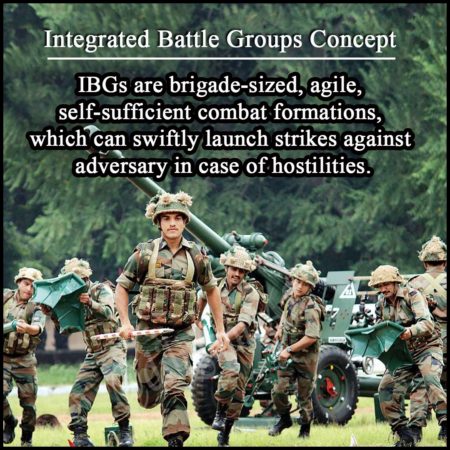Army’s first Integrated Battle Groups – self sufficient combat formations 01/08/2019 – Posted in: Daily News – Tags: doctrine of Cold Start
INTEGRATED BATTLE GROUPS
The Integrated battle group (IBG) is a new concept which the Indian Army is planning to create as a part of overall force transformation.
- IBGs can swiftly launch strikes against an adversary in case of hostilities.
Features
- IBGs are brigade-sized, agile, self-sufficient combat formations
- Each IBG would be tailor-made based on Threat, Terrain & Task and resources will be allotted based on the three Ts.
- Able to mobilise within 12-48 hours based on the location
- Concepte of IBG pilot-tested by 9 Corps
- The army will approach centre for sanction after that
Brigade size units
- While a command is the largest static formation of the Army spread across defined geography, a corps is the largest mobile formation.
- Typically each corps has three divisions and each division has three brigades.
- The idea is to reorganise them into IBGs which are brigade-sized units but have all the essential elements like infantry, armoured, artillery and air defence embedded together based on the three Ts.
- An IBG operating in a desert needs to be constituted differently from an IBG operating in the mountains.
Types
- The IBGs will also be defensive and offensive.
- The offensive IBGs would quickly mobilise and make thrust into enemy territory for strikes.
- The defensive IBGs would hold ground at vulnerable points or where enemy action is expected.
The overall transformation of the force
The army chief has initiated four measures:
- Restructuring of Army Headquarters
- Force restructuring which includes the creation of Integrated Battle Groups (IBG)
- The cadre review of officers
- Review of the terms and conditions of Junior Commissioned Officers and Other Ranks
Way ahead
The overall transformation will also see a reduction in the size of the 1.3 million Army.
Background
- After the terrorist attack on the Parliament, the Indian military undertook massive mobilisation but the Army’s formations took weeks to mobilise.
- Following this, the Army formulated a proactive doctrine known as ‘Cold Start’ to launch swift offensive but its existence was consistently denied in the past.
- Its existence was acknowledged for the first time by Gen Rawat in January 2017.
The doctrine of Cold Start
- Cold Start doctrine (CSD) is also known as Pro-Active doctrine.
- The ‘Cold Start’ doctrine of the Indian Armed Forces envisages swift deployment of troops on the western border (Pakistan) within days if a situation of a full-blown war arises.
- This doctrine aims to allow Indian forces to conduct sustained attacks while preventing a nuclear retaliation from Pakistan.
- The operation would be carried out by a unified battle group involving various branches of India’s military.
- After the conclusion of Operation Parakram in 2002, the ‘Cold Start’ doctrine began to find a place in the Indian military setup.
Source: The Hindu
Also, read more daily News
- ‘Odisha Rasagola’ gets GI Tag
- Atomic restrictions imposed by the Iran Nuclear Deal
- Rising Temperature caused by “Omega Block”
- Addressing the challenge of Red Mud
- International Tiger Day – 29 July 2019
- GST rate cut on Electric Vehicle
- Report on Great Indian Bustard
- Deep Ocean Mission
- Register of Indigenous Inhabitants of Nagaland
You are on the Best Online IAS coaching platform. You are learning under experts.
We are present on Facebook- Diligent IAS, LinkedIn- Diligent IAS, YouTube- Diligent IAS, Instagram- Diligent IAS. Get in touch with us.

